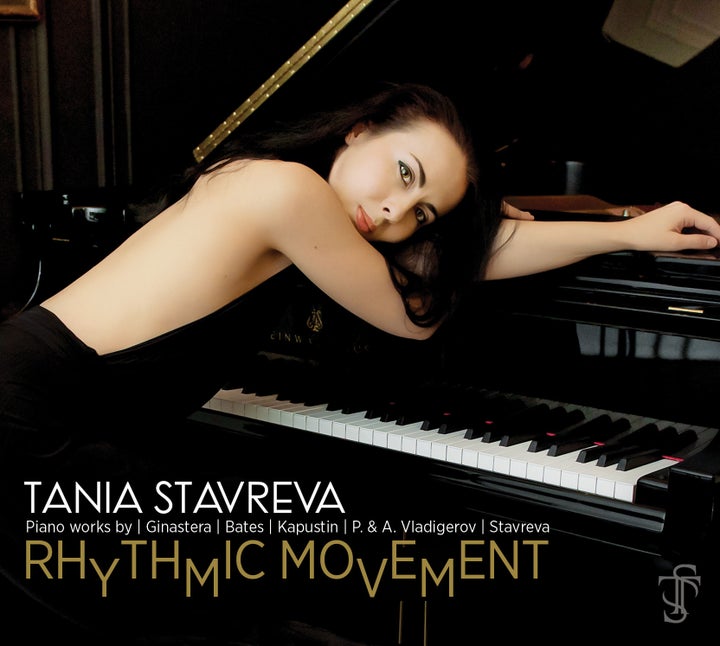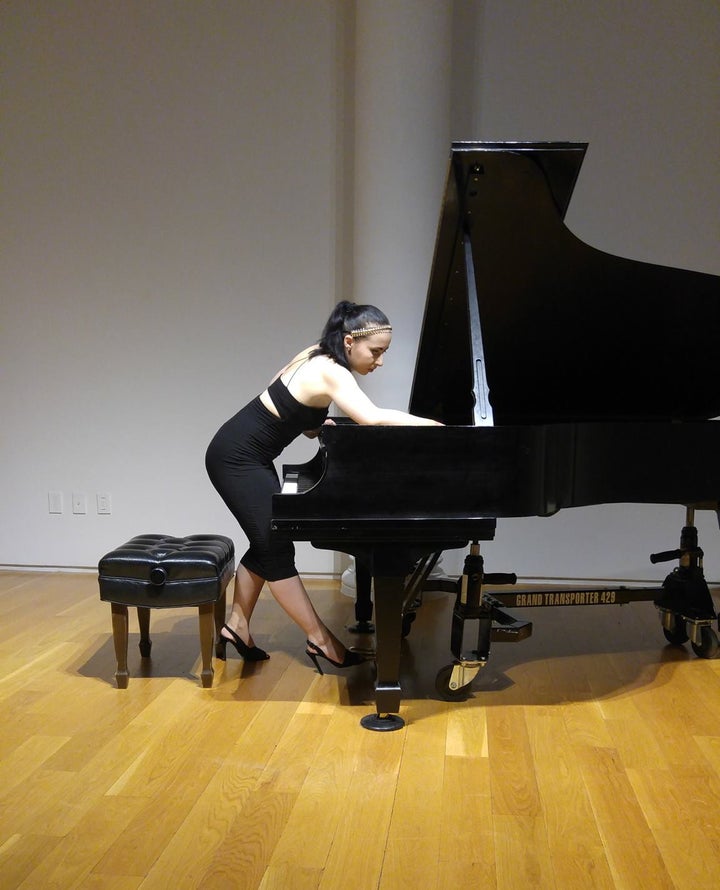“On weekends I could play with kids, but I wasn’t really a party-type kid.”

TANIA STAVREVA, pianist
Album release date: 7 January 2017 “Rhythmic Movement”
History shows that musical prodigies from gifted families respond to the pressures in different ways, some make it; some don’t. The famous ones leave lasting legacies – Beethoven who would be roused from sleep as a child to play for his drunken father; Mozart who played his first performance tour with rheumatic fever while his peers were finishing first grade. By age 21, it’s reasonable to expect some brooding introversion or at least the occasional crisis of confidence.
But then comes Bulgarian-bred Tania Stavreva with a background in classical piano as disciplined and deep as any on the concert stage, yet whose well-centered exuberance and open spirit suggest an internal balance that will take her far. Her debut album “Rhythmic Movement” slated for release January 7, 2017, calls for such metronomic virtuosity, it’s no wonder she’s keeping a steady beat as she hits engagements across the US, through Europe, and back home in New York.
Revealing only that she’s “over 21,” the diminutive knock-out has a published performance archive stretching back to 2006. Playing to sold-out rooms is normal for her whether dishing up classics in gown and pearls or smoking out clubby spaces with jazz improvisation, bare shoulders and spike heels. She talks as though she’s having a blast, even recalling an acting gig somewhere Off-Off-Broadway in 2012.

Tania Stavreva, pianist
“Music is my mother language but I love all the other areas of art… I feel that all of them are connected,” said Stavreva of the multimedia theatrical collaboration that spawned her album’s barreling title track.
With guest artist and two-time Grammy Award winning drummer Will Calhoun (Living Colour, B.B. King), the 14-track collection has celebrity power both up front and behind the scenes.
Stavreva gushed over the “genius” who engineered, mixed and recorded “Rhythmic Movement.” Renowned German-born record producer Ron Saint Germain has earned more than 60 Gold and Platinum Disc awards including four “Diamond Platinum" (10 million+). His work is associated with 19 Grammy nominations including 14 wins for notable artists (Jimi Hendrix, Muse, U2, Soundgarden, Whitney Houston, Aretha Franklin, Diana Ross, Michael Jackson, Nels Cline, and McCoy Tyner to name some).
How does a classical pianist end up playing with drums?
In 2011 Stavreva attended the Grammy Awards and met Cuban-American drummer Dave Lombardo, co-founder of the thrash metal band Slayer. “I felt power in the piano where it could sound orchestral, intimate, rhythmic, melodic, lyrical,” she recalled. “But there could be something to underline those rhythms. We didn’t plan it; it happened instantly.”
After turning Lombardo onto a YouTube recording she was excited about, he posted it on social media, and that sparked the idea for an album. Her producer got Calhoun for the recording, and playing piano in ensemble with a drummer became a major part of her musical identity.
An ARTIST with INTEGRITY – and an album to sell
Stavreva calls herself a “classical nerd.” That could be proven out in several ways: her note-perfect performances, her reverence for Bach, her life of practice-first-socialize-later commitment. “If I skipped a practice I felt something was missing like eating or taking a shower,” she admitted. “On weekends I could play with kids, but I wasn’t really a party-type kid.”
But the story behind her original composition that sets the mood of the album reveals why she sees herself as hypervigilant. During a theatrical collaboration on a modern adaptation of William Shakespeare’s “The Tempest,” someone floated the proposal of re-writing portions of a classical work to fit the occasion, altering tempi to concord with monologue, ending earlier than written, etc. The vivacious concert pianist respectfully demurred, solving the matter by composing something from scratch. That work became the title piece on her album.
“It was theatre that inspired me to start composing,” Stavreva said. “I feel that classical works are masterworks and shouldn’t be altered from their originals. I feel it makes artistic sense. And I feel that by including Track 7, the audience has the chance to hear the original.”
True to its name, the sound experience of “Rhythmic Movement” is all about that beat. Engaging with work by Bulgaria’s preeminent composer Pancho Vladigerov, known for incorporating folk elements into classical music and writing in complicated meter, Stavreva enters a playground for percussive experimentation.
The asymmetrical rhythms that characterize music that Bulgarians would dance to at weddings in 7/8 or 9/8 time can be the fodder for sophisticated expression in the hands of Vladigerov, Stavreva and the Argentine classical composer Alberto Ginastera (Tracks 4, 5, 6). The intensity builds through the album, leveling off with the jazzier lilt of a pairing by Nikolai Kapustin, to Stavreva the “Russian Gershwin.”
Stavreva then delivers a surprise for the ears by stroking the inside of the piano and plucking the strings in her original “Dark Side of the Sun.” What follows is an award-winning tribute to Alan Lomax, a blues fantasy by Mason Bates, known for his orchestral electronica.

Tania Stavreva, pianist
With characteristic enthusiasm, Stavreva explained that with “White Lies for Lomax,” the composer demanded the precision of a classical musician, requiring strict adherence to the music as written, but the trick was to play as though she were improvising. “It had to sound like I was creating it at the moment. That was the challenge,” she said with fresh wonder. “I had a lot of fun with that.”
The album intentionally weaves related elements between and among selections, even to the point of genetics. Track 13 launches a set of nine variations on a popular Bulgarian folk song (“Dilmano, Dilbero”) by Alexander Vladigerov, son of Pancho. For good measure, Stavreva has sung the tune on the previous track for the listener’s edification.
The album concludes with “Ritmico y Distorsionado,” a recounting of Track 7 but with a drum improvisation. “I said as a joke, ‘How about if we distorted the piano?’” she said gleefully. “Track 14 has distortion in particular sections, thus the name of the song.”
“Look!” she wants to say. “I just played three pieces by Barber, but you’re talking about body painting!”
EDGY is IN: Tania Talks Wardrobe and Style
Wandering onto the internet, Tania Stavreva is found against a red backdrop in black lace kicking up high leather boots. Then in a live setting, she sits demurely at the piano in backless garb, skin done up in colors, while an artist body-paints a topless model on the stage.
When Stavreva plays a Brahms or Beethoven concerto, she said, “I probably don’t want too much distraction there. I don’t want to focus on anything else.” Choosing a traditional look for a traditional program, she enjoys the gracing the full-length dress, noting that most have to wait for a wedding, a prom, or the Academy Awards to get so formal. “It’s very special,” she mused. “It’s really neat to have a profession that allows me to wear [a gown] more often.”
But other idioms loosen the collar on self expression. “If I’m playing something jazzy, it can incorporate body language and style. It’s more sexy in a way,” she explained. “If I play something more modern or jazzy or rhythmic, especially if it’s a venue that’s more edgy or serves alcohol, it calls for something more sexy. What you’d see on a jazz musician or pop artist.” As long as she can feel the pedals, she said, the heels on her shoes can be as rakish as she can stand.
Seems a silly question for one trained at Bulgaria’s National Academy of Music, but do people take her seriously? Music critics have described her as "exceptional, entrancing, fun!” and "a fully formed and fearsomely talented pianist." She has been called “a piano dynamo” and more to the point, “a very unique pianist, combining genuine quality with a refreshing approach to programing with superior technical abilities” renowned internationally for “having some of the most precise fingering of any of the twenty-something generation of pianists, bar none.” A reading of her bio and list of engagements is boggling.
Nevertheless, she said, “A person sees a young woman dressed in a more modern way, I feel they make a judgment before they even hear the music, so it’s much harder to convince them of what you can do.” All it took was a single creative collaboration with a body painter, and a cliché was born: “Oh, no body painting today?” Countless traditional performances and prestigious accolades reduced to one memorable visual.
“It was around the time I was also working with one of the most difficult pieces in the world written for piano by Samuel Barber – “Piano Sonata.” As her senior recital enshrined on YouTube will attest, she played it to good effect. “Look!” she wants to say. “I just played three pieces by Barber, but you’re talking about body painting!”
Her ultimate preference is boots with leggings and a short dress. “That’s the real me,” she said. But the look has to match the program.

Tania Stavreva, pianist
Hopes for the Future of “Rhythmic Movement”
The idea of making an album came later for Stavreva. After years of avoiding what sounded to her like entering a racket where musicians suffer mistreatment at the hands of record labels, she decided to give her audience what they want.
“People after my concerts would ask me, ‘How can I take this music home?’ It’s something my audience has been asking for. I respect my audience and care about them very much, so I wanted to give this to them.”
She added with assertive sincerity, “Basically this is something to express who I am at this time in my life. I wanted to start from that phase in my life and be honest with my audience about this.”
In the spring of 2017, Stavreva will start working with exclusively Bulgarian composers incorporating more folk themes and devices into the next phase of her work.
